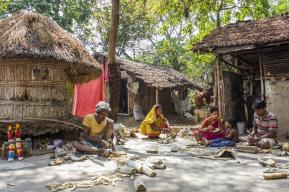Project
Strengthening the Conservation and Management of Lumbini, the Birthplace of Lord Buddha
Lumbini, the birthplace of Lord Buddha, located in Western Nepal, and the landscape surrounding Lumbini related to Lord Buddha’s life was inscribed on the UNESCO World Heritage List in 1997 in recognition of its outstanding universal value.
The two other sites closely related to Buddha’s life, included in the tentative list for World Heritage status in 1996 are - Ramagrama, the only relic stupa not opened by Emperor Ashoka in the third century BCE, and Tilaurakot-Kapilavastu, the archaeological remains of the ancient Shakya Kingdom.
As an ensemble, these sites are emblematic landmarks in the Greater Lumbini Area, which bears testimony to a rich spiritual and cultural area since ancient times. Their preservation and development are important not only for Nepal but for Buddhist communities worldwide.
UNESCO is implementing the project on Strengthening Conservation and Management of Lumbini, the Birthplace of Lord Buddha that aims to improve protection and management of the Lumbini World Heritage property and improve strategy to protect the Greater Lumbini Area and its wider setting, including but not limited to Tilaurakot-Kapilavastu, included in Nepal’s Tentative List for World Heritage, contributing to achievement of SDG 11.4 on the protection of the world’s cultural heritage.
Funded by the Japanese Government, UNESCO is implementing the project in collaboration with Nepal’s Department of Archaeology (under the Ministry of Culture, Tourism and Civil Aviation) and the Lumbini Development Trust. The previous three phases of the project started in 2010 and this phase of the project which started in 2022 has achieved several significant results.
- Conservation of the three most emblematic monuments of Lumbini, namely the Marker Stone, the Nativity Sculpture and the Ashoka Pillar. Practical manual on conservation of archaeological remains inside the Mayadevi Temple in Lumbini.
- Successful excavations within the Mayadevi Temple, which for the first time revealed evidence of structures dating back to the 6th century BCE – during the lifetime of Buddha.
- Archaeological Risk Maps for the Sacred Garden of Lumbini, Ramagrama and the ancient Tilaurakot-Kapilavastu city site and Chatradei: a site on its buffer zone, and a management plan for Lumbini, resulting in enhanced protection and planning.
- The results of the geophysical survey and excavations of Tilaurakot-Kapilavastu have revealed the most comprehensive plan of an Early Historic city in South Asia, with a system of roads at cardinal directions, structures and other urban features within a fortification wall, including a monumental walled palatial complex at the centre of the ancient walled city and and a large monastic complex at the Eastern Stupa site.
- Enhanced walkways for pilgrims and visitors within the Sacred Garden of Lumbini, and Tilaurakot-Kapilavastu, designed with respect to new non-intrusive and reversible guidelines.
- 235 heritage sites within the Greater Lumbini Area, in particular of Kapilvastu and Rupandehi Districts, mapped on GIS.
- Support to the Government of Nepal in the preparation of nomination of the Tilaurakot-Kapilavastu site on the World Heritage List, which Nepal plans to submit in 2024.
- Delivered capacity strengthening and training for conservation and archaeological staff of both the Department of Archaeology and the Lumbini Development Trust, as well as master’s level students from Nepal’s Tribhuvan and Lumbini Buddhist Universities.
- Provides strategic and technical guidance for the conservation and management of Lumbini and Tilaurakot-Kapilavastu through the International Scientific Committee.
- Annual heritage festivals in Tilaurakot-Kapilavastu, engaging local schools and communities, communicating importance of heritage protection, as well as promoting intangible heritage.
Publications
- Report on activities carried out on the conservation of Archaeological remains in Lumbini and Tilaurakot under the project, including maintenance treatment and practical action to be carried out in. (2021)
- World Heritage nomination process of the Tilaurakot site and conservation and tourism plan for the Tilaurakot site and its environs (2021)
- Excavating, conserving and presenting Tilaurakot-Kapilavastu (UNESCO tentative World Heritage site): final report of the March-April 2021 archaeological field activities (2021)
- Excavating, Conserving and Presenting Tilaurakot-Kapilvastu (UNESCO Tentative World Heritage Site): final report of the November 2019 and January-March 2020 archaeological field activities (2020)
- Ramagrama Geophysical Survey and Preparation of Risk Map, Report of the 2019 Archaeological field activities (2019)
- Excavating, conserving and presenting Tilaurakot-Kapilavastu: final report of the 2019 archaeological field activities (2019)
- The Sacred Garden of Lumbini (2019)
- The Greater Lumbini Area Religious Archaeological Sites (2018)
- Strengthening the conservation and management of Lumbini, the birthplace of the Lord Buddha, world heritage property (phase II): final report of the fourth (Jan-Feb 2017) season of field activities (2017)
- The Archaeological Site Catalogue — Rupandehi District (2017)
- The Archaeological Site Catalogue — Kapilvastu District; Draft (2016)
- Strengthening the conservation and management of Lumbini, the birthplace of the Lord Buddha, world heritage property (phase II): final report of the third (Jan-Feb 2016) season of field activities (2016)
- Strengthening the conservation and management of Lumbini, the birthplace of the Lord Buddha, world heritage property (phase II): final report of the second (Jan-Feb 2015) season of field activities (2015)
- Strengthening the conservation and management of Lumbini, the birthplace of the Lord Buddha, world heritage property (phase II): final report of the first (Jan-Feb 2014) season of field activities (2014)
- Heritage impact assessment of tourism on Lumbini world heritage property (2013)
- Lumbini: the birthplace of Lord Buddha in Nepal. Completing the Kenzo Tange Master Plan (2013)
- Strengthening Conservation and Management of Lumbini, the birthplace of Lord Buddha, WH property (2013):
- Background information on Lumbini and the Greater Lumbini Area (2013)
- Environmental impact assessment of industrial development around Lumbini, the birthplace of the Lord Buddha, World Heritage Property (2012)- Main Report, Summary -English, Nepali
- Strengthening conservation and management of Lumbini, the birthplace of Lord Buddha, WH property. Identifying, evaluation and interpreting the physical signature of Lumbini for presentation, management and long term protection (2012):
- Lumbini: present status and future challenges (2006)








